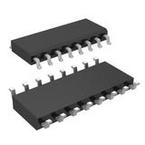Part Datasheet Search > Amplifiers,Buffers > ADI > AD600ARZ-RL Datasheet PDF
AD600ARZ-RL Datasheet PDF - ADI
| Manufacturer: | ADI |
| Category: | Amplifiers,Buffers |
| Case Package: | SOIC-16 |
| Description: | IC OPAMP VGA 35MHz 16SOIC |
| Documentation: | AD600ARZ-RL Datasheet (32 Pages)Pinout Diagram on6 PageHot Package Outline Dimension on27 Page Part Numbering System on29 Page |
| Pictures: |
AD600ARZ-RL Datasheet PDF
ADatasheet has not yet included the datasheet for AD600ARZ-RL
If necessary, please send a supplementary document request to the administrator

AD600ARZ-RL Datasheet PDF (32 Pages)
AD600ARZ-RL Specifications
| TYPE | DESCRIPTION |
|---|---|
| Mounting Style | Surface Mount |
| Number of Pins | 16 Pin |
| Case/Package | SOIC-16 |
| Supply Current | 11 mA |
| Number of Circuits | 2 Circuit |
| Number of Channels | 2 Channel |
| Power Dissipation | 600 mW |
| Slew Rate | 275 V/μs |
| Gain Bandwidth Product | 35 MHz |
| Input Bias Current | 350 nA |
| Operating Temperature (Max) | 85 ℃ |
| Operating Temperature (Min) | -40 ℃ |
| 3dB Bandwidth | 35 MHz |
| Power Dissipation (Max) | 600 mW |
| Supply Voltage (Max) | 10V ~ 15V |
AD600ARZ-RL Size & Package
| TYPE | DESCRIPTION |
|---|---|
| Product Lifecycle Status | Active |
| Packaging | Tape & Reel (TR) |
| Size-Length | 10.5 mm |
| Size-Width | 7.6 mm |
| Size-Height | 2.35 mm |
| Operating Temperature | -40℃ ~ 85℃ |
AD600ARZ-RL Environmental
AD600ARZ-RL Function Overview
Product Details
●The AD600/AD602 dual channel, low noise, variable gain amplifiers are optimized for use in ultrasound imaging systems, but are applicable to any application requiring precise gain, low noise and distortion, and wide bandwidth. Each independent channel provides a gain of 0 dB to +40 dB in the AD600 and -10 dB to +30 dB in the AD602. The lower gain of the AD602 results in an improved signal-to-noise ratio (SNR) at the output. However, both products have the same 1.4 nV/√Hz input noise spectral density. The decibel gain is directly proportional to the control voltage, accurately calibrated, and supply and temperature-stable.
●To achieve the difficult performance objectives, a proprietary circuit form, the X-AMP®, was developed. Each channel of the X-AMP comprises a variable attenuator of 0 dB to -42.14 dB followed by a high speed fixed gain amplifier. In this way, the amplifier never has to cope with large inputs, and can benefit from the use of negative feedback to precisely define the gain and dynamics. The attenuator is realized as a 7-stage R-2R ladder network having an input resistance of 100 W, laser trimmed to ±2%. The attenuation between tap points is 6.02 dB; the gain-control circuit provides continuous interpolation between these taps. The resulting control function is linear in dB.
●The gain-control interfaces are fully differential, providing an input resistance of ~15 M W and a scale factor of 32 dB/V (that is, 31.25 mV/dB) defined by an internal voltage reference. The response time of this interface is less than 1 µs. Each channel also has an independent gating facility that optionally blocks signal transmission and sets the dc output level to within a few millivolts of the output ground. The gating control input is TTL- and CMOS-compatible.
●The maximum gain of the AD600 is 41.07 dB, and the maximum gain of the AD602 is 31.07 dB; the -3 dB bandwidth of both models is nominally 35 MHz, essentially independent of the gain. The SNR for a 1 V rms output and a 1 MHz noise bandwidth is typically 76 dB for the AD600 and 86 dB for the AD602. The amplitude response is flat within ±0.5 dB from 100 kHz to 10 MHz; over this frequency range, the group delay varies by less than ±2 ns at all gain settings.
●Each amplifier channel can drive 100 W load impedances with low distortion. For example, the peak specified output is ±2.5 V minimum into a 500 W load, or ±1 V into a 100 W load. For a 200 W load in shunt with 5 pF, the total harmonic distortion for a ±1 V sinusoidal output at 10 MHz is typically -60 dBc.
●The AD600J/AD602J are specified for operation from 0°C to 70°C and are available in 16-lead PDIP (N) and 16-lead SOIC packages. The AD600A/AD602A are specified for operation from -40°C to +85°C and are available in 16-lead CERDIP (Q) and 16-lead SOIC packages. The AD600S/AD602S are specified for operation from -55°C to +125°C, are available in a 16-lead CERDIP (Q) package, and are MIL-STD-883 compliant. The AD600S/AD602S are also available under DESC SMD 5962-94572.
●AD600 - Gain Range: 0 dB to 40 dB
●AD602 - Gain Range: -10 dB to + 30 dB
●### Features and Benefits
● 2 channels with independent gain control
●Linear in dB gain response
● 2 gain ranges
●AD600: 0 dB to 40 dB
●AD602: -10 dB to +30 dB
● Accurate absolute gain: ±0.3 dB
● Low input noise: 1.4 nV/√Hz
● Low distortion: -60 dBc THD at ±1 V output
● High bandwidth: dc to 35 MHz (-3 dB)
● Stable group delay: ±2 ns
● Low power: 125 mW (maximum) per amplifier
● Signal gating function for each amplifier
● Drives high speed ADCs
● MIL-STD-883-compliant and DESC versions available
show more
AD600ARZ-RL Documents
AD600 Documents
ADI
ANALOG DEVICES AD600JRZ Programmable/Variable Amplifier, 2Channels, 2 Amplifier, 35MHz, 0 °C, 70℃, ± 4.75V to ± 5.25V
ADI
ANALOG DEVICES AD600ARZ Programmable/Variable Amplifier, 2Channels, 2 Amplifier, 35MHz, -40℃, 85℃, ± 4.75V to ± 5.25V
ADI
ANALOG DEVICES AD600JNZ Programmable/Variable Amplifier, 1Channels, 1 Amplifier, 35MHz, 0 °C, 70℃, ± 4.75V to ± 5.25V
Part Datasheet PDF Search
Example: STM32F103
72,405,303 Parts Datasheet PDF, Update more than 5,000 PDF files ervery day.

